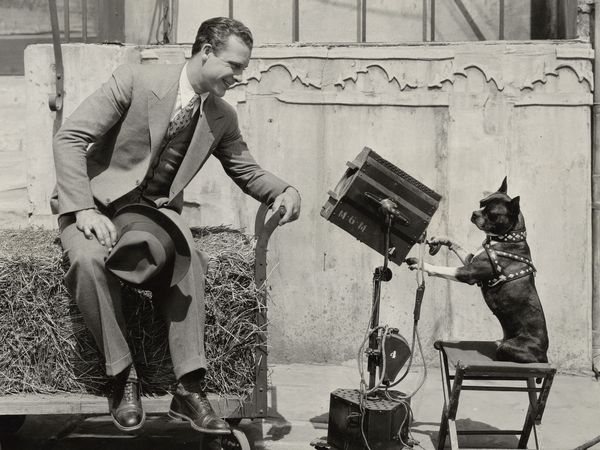IN OLD KENTUCKY
(Ritorno alla vita)
John M. Stahl (US 1927)
In 1927, Stahl left Metro-Goldwyn-Mayer to become an executive of the independent Tiffany Pictures, renamed Tiffany-Stahl Productions, and while acting as a producer there took a three-year hiatus from directing. His last film for M-G-M, In Old Kentucky, thus also became the last silent film he directed. It seems an unusual project for him, a departure from the female-centered melodramas and light comedies for which he was known in the 1920s. The source was an 1893 stage melodrama by Charles T. Dazey, which it is impossible to resist calling a warhorse, both for its equestrian subject matter and the frequency with which it returned over the decades, both on stage and screen. (Louis B. Mayer had already produced an adaptation, directed by Marshall Neilan, in 1919, and a later version in 1935 would star Will Rogers.) These various films diverge widely, and each took great liberties with the play: Stahl’s version, adapted by A.P. Younger, focuses on the aftermath of World War I, and culminates in a Kentucky Derby race that manages to simultaneously heal the fortunes of a ruined horse-breeding family and the psyche of the war-damaged son and heir, played by the tragically troubled actor James Murray.
The Bronx-born Murray was allegedly an unknown extra when director King Vidor discovered and cast him as the lead in The Crowd (1928), a performance that brought him immortality but which is invariably linked to the observation that his own sad fate echoed the film’s downbeat arc. Though his widely admired work in The Crowd led to other starring roles, a drinking problem seemingly tied to deep insecurity soon derailed his career; alcoholic and destitute, Murray drowned in 1936, whether accidentally or as a suicide. (In a sad coincidence, screenwriter A.P. Younger committed suicide in 1931.) If the account of Murray’s discovery is true, this would suggest that In Old Kentucky was made after, though released before, Vidor’s film. Though this film does not approach the level of The Crowd, the role of Jimmy Brierly also draws on Murray’s raw emotional intensity and foreshadows his personal self-destructiveness. Before going off to war, Jimmy is a carefree, golden youth; when he returns, he is a drunken, dissolute gambler who shuns or quarrels with all his loved ones.
That his transformation is the result of combat trauma (“shell shock,” in World War I parlance) is never made explicit, but comes across strongly in Murray’s performance, redolent of self-loathing buried under a self-medicated haze. It is reinforced by the narrative link between Jimmy and Queen Bess, a prize racehorse contributed to the war effort by the Brierly patriarch; the two meet amid the rain, mud, and murk of the trenches, and much later the scarred and battered Queen Bess is recovered by the now-impoverished Brierlys and entered in the Kentucky Derby. Not surprisingly, this plot was met with considerable derision when the film came out: Variety’s review was so hostile (“inconceivably asinine in story and with kindergarten technique”) that M-G-M pressured them into a second review, with only slightly more favorable results. Even warmer reviews generally took for granted that the plot was ludicrous and the film’s success was in spite of it.
Another element of the film that drew attention at the time and remains of interest is the substantial amount of time devoted to African-American actors Lincoln Perry, better known as Stepin Fetchit, as the ne’er-do-well Highpockets, and Carolynne Snowden as his long-suffering fiancée, Lily May, who works as a maid. These black characters are mainly treated as comic relief, much of it offensive to modern viewers, but given the extremely poor standards of such roles, they are presented sympathetically and allowed space for performances that, at least occasionally, feel natural and affecting. Snowden’s close-ups are so peculiarly touching that her recurring role as the butt of white laughter feels even more cruel (a familiar face, she would go on to play small roles, often as a singer or dancer, in well-known films like A Day at the Races, Murder at the Vanities, and Roman Scandals), and the eternally controversial Perry’s performance is more sly and rascally, less exaggeratedly slow-witted than the later style that would become notorious. This was his breakthrough film, and Stahl would cast him in three productions at Tiffany-Stahl. There was even talk of his directing Perry and Snowden in a film with an all-black cast; this never happened, though the director’s interest in African-American characters would return with greater nuance in Imitation of Life (1934).
Imogen Sara Smith

regia/dir: John M. Stahl.
scen: A. P. Younger, Lew Lipton; dalla pièce di/based on the play by Charles T. Dazey (1893).
didascalie/titles: Marian Ainslee, Ruth Cummings.
photog: Maximilian Fabian.
mont/edit: Basil Wrangell, Margaret Booth.
scg/des: Cedric Gibbons, Ernest [Ernst] Fegté.
cost: Gilbert Clark.
asst dir: David Friedman.
cast: James Murray (Jimmy Brierly), Helene Costello (Nancy Holden), Wesley Barry (“Skippy” Lowry), Dorothy Cumming (Mrs. Brierly), Edward Martindel (Mr. Brierly), Harvey Clark (Dan Lowry), Stepin Fetchit [Lincoln Perry] (Highpockets), Carolynne Snowden (Lily May), Nick Cogley (Uncle Bible), [Sidney Bracy], Jiggs the dog.
prod: Metro-Goldwyn-Mayer Pictures.
dist: M-G-M.
uscita/rel: 29.10.1927.
copia/copy: 35mm, 6154 ft. (orig. 6646 ft.), 78′ (21 fps); did./titles: ENG.
fonte/source: Library of Congress Packard Center for Audio-Visual Conservation, Culpeper, VA.


 Italiano
Italiano